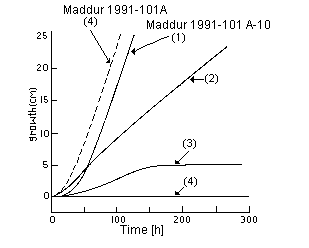Presence of nuclei carrying a recessive lethal gene in a wild isolate of Neurospora
Alka Pandit, Bhuvana Kannan and Ramesh Maheshwari - Department of Biochemistry,
Indian Institute of Science, Bangalore 560 012.
To learn if wild isolates of Neurospora can be heterokaryotic, we studied a strain
(Maddur 1991-101 A) of Neurospora intermedia from burnt sugar cane. This strain has
grown normally in over 50 subcultures and was selected because it produced a pure crop of microconidia following a procedure we described earlier (A. Pandit and R. Maheshwari 1993 Fungal Genet. Newsl. 40:64-65). Homokaryotic cultures were derived by plating microconidia produced by mycelium grown over cellophane agar. Of 159 homokaryotic cultures, one (Maddur 1991-101 A-10) was immediately noticeable because of its poor growth and conidiation when transferred to fresh medium. After another transfer its vigor declined further. Serial subculturing resulted in progressive decline in growth rate and in the fourth subculture it ceased growth altogether (Fig. 1). Thus the homokaryotic derivative, Maddur 1991-101 A-10, showed a senescent phenotype. It was crossed to a wild-type N. intermedia (FGSC 3417). Progeny from reciprocal crosses were serially subcultured at weekly intervals. It was observed that the senescent phenotype in both crosses was inherited in a 1:1 ratio showing the mutant form was due to a single nuclear gene. A cross between two senescence-prone f1 cultures yielded progeny which all died in 5 to 11 serial subcultures. It was noted that initially all ascospore-derived cultures conidiated profusely even though the parents has lost vigor and had poor conidiation at the time crosses were made. Moreover, the number of passages before death was manifested varied in progeny subcultures, suggesting the presence of genes which influence the expression of the mutant lethal gene. The mutant lethal gene has been successfully introgressed into N. crassa through six backcrosses and has been maintained in heterokaryons.
This study shows that a recessive lethal gene has arisen and persists in wild-collected Neurospora but is masked in the heterokaryotic mycelium until it segregates in the spores.
Acknowledgement: This work was supported by the Department of Science and
Technology, Government of India.

Fig. 1. Comparative growth of the parent heterokaryon, Maddur 1991-101 A (broken line) and of the homokaryon, Maddur 1991-101 A-10 (solid line), in race tubes. The subculture number is given in parentheses.

